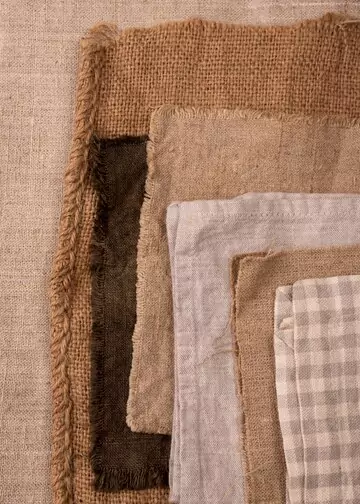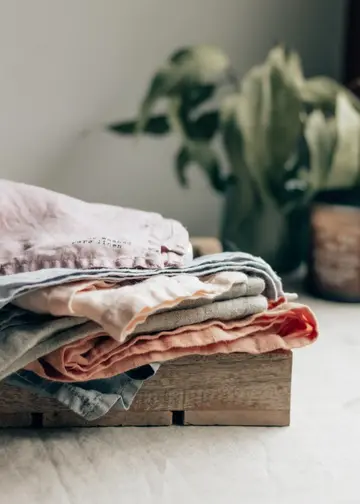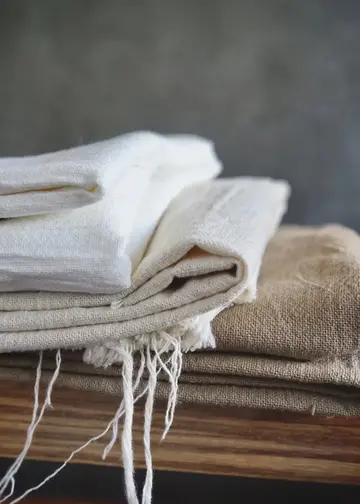Linen, a highly sought-after textile, derives from the fibers of the flax plant. It finds extensive use in the apparel and textile industries. Comparable to cotton, linen stands out due to its superior absorbency and quick drying properties.
Its natural coolness and freshness make it a versatile choice for crafting towels, garments, tunics, dresses, and shirts. Linen excels in providing comfort in hot and humid climates, readily soaking up moisture and drying faster than cotton. Nevertheless, its production demands considerable time and resources, rendering it relatively pricey compared to cotton.
A Glimpse into Linen’s Historical Journey
Linen fabric boasts a rich and lengthy history, with traces dating back thousands of years. While conclusive evidence of its prehistoric use remains elusive, flax fibers from around 36,000 years ago have been unearthed in a cave in Georgia, hinting at its early adoption by ancient civilizations.
Linen’s origins can be traced to ancient Mesopotamia, primarily favored by the elite classes. In ancient Egypt, it served as both mummy wrappings and daily attire, owing to its suitability for extreme heat. Over centuries, linen has found utility not only in clothing but also in items such as tablecloths and bedsheets.
Before delving into the world of linen fabric, it’s essential to understand the intricate process of cultivating flax, the plant from which this remarkable textile originates.
The Ideal Environment for Flax Growth
Flax, the source of linen fiber, thrives when exposed to a harmonious blend of sunlight and humidity. The oceanic climate found in coastal regions provides the perfect conditions for its cultivation. Here, the nurturing hand of nature naturally manages the irrigation process, ensuring optimal growth.
Sustainability in Action
One remarkable aspect of flax cultivation is its positive impact on the environment. As flax plants grow, they absorb significant amounts of carbon dioxide from the atmosphere and convert it into life-sustaining oxygen. This carbon sequestration contributes to cleaner, fresher air.
To maintain the health and quality of flax fibers, crop rotation becomes a crucial practice. Flax draws essential nutrients from the soil, necessitating rotations of 6 to 7 years between crops. This ensures the soil remains fertile and capable of supporting successive flax harvests.
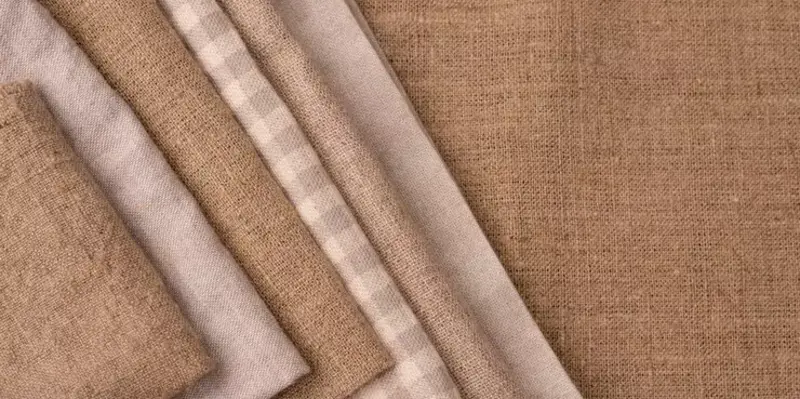
Pesticide Minimalism
Unlike many other crops, flax cultivation requires minimal pesticide use. The need for such chemical inputs is further reduced due to the plant’s natural resistance to pests and diseases. Consequently, the environmental impact of flax farming is significantly lower, making it a sustainable choice for conscientious growers and consumers alike.
Linen, a versatile and beloved textile, traces its origins back to the flax plant. Its production journey is a fascinating process that combines tradition, craftsmanship, and sustainable practices.
Let’s embark on a journey through the stages of linen fabric production:
1. Cultivation and Harvesting:
The journey of linen begins with the cultivation of flax. As mentioned earlier Flax is grown in regions with a suitable climate, where it can receive the right balance of sunlight and humidity. Coastal areas with oceanic climates often provide ideal conditions. Flax plants require regular inspection and care by skilled growers to ensure optimal growth. The cultivation process also involves crop rotation, typically with 6 to 7 years between flax crops to maintain soil health.
2. Retting:
Once mature, flax plants are harvested, and their stalks undergo a process called retting. Retting involves exposing the flax stalks to moisture, either through dew, rain, or controlled water soaking. This natural process softens the stalks and allows the fibers to be separated from the woody parts of the plant.
3. Breaking and Scutching:
After retting, the flax stalks are mechanically processed through a series of steps. Breaking is the first stage, where the dried flax stalks are broken into smaller pieces to facilitate fiber extraction. Scutching follows, which involves further separating the fibers from the remaining woody material. This process results in a bundle of long, fine flax fibers known as “Strick.”
4. Hackling:
The strick is then hackled, a meticulous combing process that aligns the fibers and removes any remaining impurities. Hackling also divides the fibers into various grades, depending on their length and fineness. The longest and finest fibers are typically reserved for the highest-quality linen products.
5. Spinning:
Once the flax fibers are hackled and prepared, they are ready for spinning. Linen fibers are spun into threads or yarns, a critical step in textile production. These threads can be further twisted and combined to create various yarn sizes and types, depending on the desired linen fabric.
6. Weaving:
The spun linen threads are then woven into fabric on looms. Weaving patterns and techniques vary, allowing for the creation of different textures and designs. Linen’s natural luster and breathability make it a popular choice for garments, tablecloths, and other textile products.
7. Bleaching and Dyeing:
To achieve the desired color and finish, linen fabric can undergo bleaching and dyeing processes. While natural linen is prized for its neutral, earthy tones, dyeing allows for a wide range of vibrant colors. Bleaching, on the other hand, can brighten the fabric and remove any remaining impurities.
8. Finishing:
After weaving, linen fabric undergoes finishing processes to enhance its texture and appearance. This may include processes like softening, calendaring, or starching, depending on the intended use of the fabric. Finishing also ensures that the linen is wrinkle-resistant and ready for its final destination.
9. Cutting and Sewing:
Once linen fabric is ready, it is cut and sewn into various products, from clothing and bed linens to tablecloths and upholstery. Skilled artisans and manufacturers transform the fabric into the final, functional items that we use in our everyday lives.

However, Safilin, a company specializing in linen cloth production, employs a more costly but superior method. Safilin possesses unique expertise in linen yarn manufacturing, and after the scutching and combing phases, the next crucial step is linen spinning.
The Safilin linen spinning facility stands as the sole establishment globally to utilize three distinct spinning technologies: wet spinning, dry spinning, and open-end spinning.
Flax Preparation
Following the combing process, a preparatory phase ensues. In a manner akin to a champagne maker blending various vintages, Safilin meticulously combines at least 24 batches of combed ribbons from different sources and harvest years to ensure uniform quality and color in their linen yarn, regardless of the harvest’s quality. Safilin also uniquely maintains a substantial stock of scutched fibers, sufficient for over 10 months of production, providing a buffer against harvest-related risks.
Combing flax fiber ribbons undergo an intricate blending process. Preparation consists of five stages, during which the ribbons are blended and stretched to create a sliver. This process typically spans approximately one week, culminating in a slightly plied sliver.
Washing and Bleaching
After the preparatory phase, the sliver undergoes washing and optional bleaching processes to prepare it for dyeing. These operations take about 8 hours and serve to eliminate residual pectin from the fiber, resulting in the familiar sandy color. The sliver then undergoes a resting period to remove excess moisture.
Linen Spinning
The sliver is then blended with others awaiting spinning. It is humidified to achieve the desired finesse, strength, and uniformity. The final stage involves plying it to complete the transformation and produce linen yarn. Safilin employs two distinct spinning technologies:
• Dry Spinning: Utilizing combing or scutching flax tow, which is carded and spun. This yields a thicker and more rustic fiber, often used in the clothing industry.
• Wet Spinning: Exclusively utilizing long, combed fibers to create thinner and more uniform yarn. This type of yarn is mainly intended for the clothing industry, as well as for table/bed linens and curtain manufacturing.
Winding – The Final Stage of Linen Spinning
The last stage involves a thorough quality control check before the spools are dispatched to customers. State-of-the-art technology is employed to detect and eliminate defects, ensuring the highest quality standards. The winding workshop accommodates various product presentation requirements, such as weaving cones, packaging for dyeing, cardboard tubes, tubeless spools, entwined spools, and balls. Spools intended for wet spinning are sealed in bags to preserve their moisture levels. They are then loaded onto pallets and shipped to customers.
Linen spinning is a complex and entirely mechanical process that demands skilled and experienced personnel who possess a mastery of precise techniques. This transformation process requires expertise and constant monitoring to deliver premium-quality yarn, ultimately resulting in long-lasting, high-quality products.
Advantages and Disadvantages of Linen Fabric
Linen fabric unique characteristics have made it a favorite choice for various applications, but it’s essential to understand both its strengths and weaknesses before incorporating it into your lifestyle.
Advantages of Linen Fabric
1. Breathability and Comfort
Linen’s breathability is unparalleled. It allows air to flow freely through the fabric, making it ideal for hot and humid climates. When you wear linen clothing, you’ll experience exceptional comfort as it keeps you cool and dry. This breathability is one of the primary reasons linen is a summer wardrobe staple.
2. Durability and robustness
One of the major advantages of flax yarn is its robustness. The fibre’s nature and its length make it a sturdy material, perfect for textile manufacturing. It is not uncommon to find bedlinen dating back to several years or even centuries ago in perfect condition. Who hasn’t found linen handkerchiefs or bedlinen in their grandparents’ wardrobes.
3. Environmental Sustainability
For environmentally conscious individuals, linen is a top pick. Flax, the plant linen is made from, requires significantly fewer pesticides and water than cotton, making it a more sustainable choice for fabric production. Linen is biodegradable, further reducing its environmental impact, what is more, its cultivation does not require any artificial irrigation system.
4. Timeless Aesthetics
Linen has a timeless, classic appeal. Its natural texture and slightly wrinkled appearance give it a rustic charm. Linen garments and home furnishings can effortlessly elevate your style, whether you prefer a casual or sophisticated look.
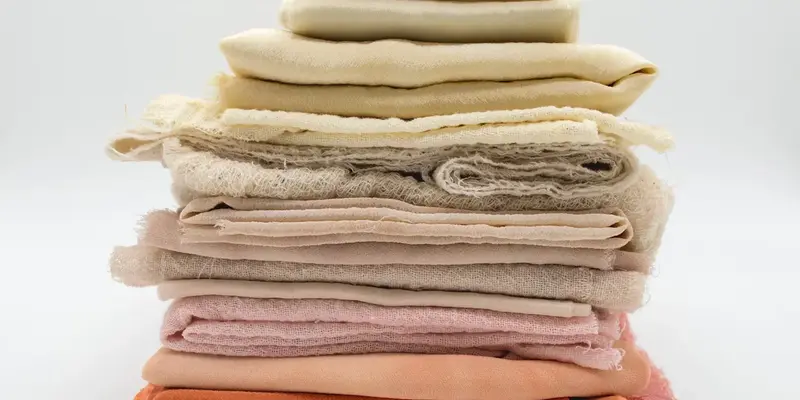
Disadvantages of Linen Fabric
1. Wrinkles Easily
While the characteristic wrinkles of linen are part of its charm, they can be a drawback for some. Linen clothing tends to crease easily, requiring ironing or steaming to maintain a polished appearance.
2. Absorbs Moisture
Linen’s ability to absorb moisture can be both an advantage and a disadvantage. While it keeps you cool by wicking away sweat, it can feel damp in very humid conditions, potentially leading to discomfort.
3. Price Point
Quality linen can be relatively expensive compared to other fabrics. This higher price is often justified by its durability and eco-friendliness, but it may not fit everyone’s budget.
Applications of Linen Thread: Versatile and Essential
Flax, a remarkable plant with a history spanning thousands of years, holds great significance today in the face of environmental challenges. Over the years, it has found applications in diverse industries, including clothing, furniture, and composite materials.
• Flax Fiber in the Clothing Industry
In the clothing and household linen industry, flax takes the form of linen yarn and proves to be a valuable textile choice. Linen has established itself as a go-to option for those seeking ultimate comfort. It boasts rapid drying capabilities, keeps you cool during the sweltering summer months, and provides warmth during winter, all thanks to its exceptional thermoregulatory properties.
• Flax Fiber in the Furniture Industry
Linen yarn finds its way into various furnishings, such as sofa covers, cushions, curtains, and chair seats. These are just a few examples of commonly used linen textiles in the furniture industry.
• Linen Yarn in Composite Manufacturing
Linen yarn also plays a crucial role in the development of technical textiles utilized in the composite industry. With insulation properties surpassing popular textiles by 15% to 30%, linen yarn holds a significant position in the thermal insulation sector. It’s now a viable alternative to traditional materials like glass fiber, contributing to more sustainable composite manufacturing processes.
• Bookbinding:
In bookbinding, linen thread is indispensable. It is used to sew together the pages of books, providing durability and longevity to literary works.
• Musical Instruments:
Some musical instruments, particularly stringed instruments like violins and cellos, use linen thread in various parts for string winding and repairs.
so linen thread is a remarkably versatile material that has stood the test of time due to its exceptional properties. From clothing to medicine, from art to industry, its applications are as diverse as they are essential, making it an enduring and valued resource in our modern world.
Tips to make linen fabric last longer and take care of it
Linen, a natural and eco-friendly material, possesses the unique quality of growing more beautiful with time. To ensure your linen products age gracefully, consider these essential care tips:
1. Vinegar Soak for Color Fixation and Softening
As a timeless trick, immerse your newly acquired linen product in a cold water bath with a dash of white vinegar. Allow it to soak for approximately 12 hours before the initial wash. This not only helps set the colors but also imparts a delightful softness to your linen.
2. Machine Washing Guidelines
Prioritize sorting your laundry by color to prevent any potential color bleeding or fading. Pay close attention to the other fabrics in the machine, as materials like polyester can produce lint that may damage your linen clothes.
Linen’s resilience allows for washing at temperatures of up to 60°C, but for eco-conscious care, opt for a gentler 30°C wash. A moderate spin cycle, between 600 and 800 rpm, reduces the risk of fiber damage.
Choose a natural detergent whenever possible, as it’s more environmentally friendly. Avoid chlorine-based detergents, as they can lead to yellowing of fabrics.
3. Linen Drying
Air-drying is the preferred method for linen textiles. If you have access to outdoor space, drying your linen products in the open air is even better. Linen’s quick-drying nature means your items will be ready in no time.
While tumble drying is an option for softening linen fibers, it’s important to note that it consumes substantial energy.
4. Ironing Linen
Linen’s charming wrinkles are often embraced, but if you prefer a neater look, ironing is an option. Always iron linen when it’s damp, as the moisture softens the fibers and facilitates smoother ironing. Be cautious not to use excessive heat during ironing, as it can potentially damage or scorch the fabric.
5. Storage Matters
To preserve the shape and minimize wrinkling, store your linen clothes on hangers in your closet. This simple step helps maintain their pristine condition.
By following these care tips, you can ensure your cherished linen products not only stand the test of time but also continue to exhibit their natural beauty, all while minimizing your environmental footprint.
The Prime Regions for Flax Cultivation and Linen Fabric Production
When it comes to flax cultivation and the production of exquisite linen fabric, certain regions shine brightly on the global stage. These areas not only house a significant portion of the world’s linen culture but also boast some of the finest linen craftsmanship. Let’s explore these renowned hubs of flax and linen production.
1. The Coastal Belt from Caen to Amsterdam:
An astounding 80% of all flax cultures find their home in the picturesque coastal zone extending from Caen to Amsterdam. This stretch of land is where you’ll discover some of the most exquisite linen fabric in the world. The combination of the maritime climate and rich, well-drained soils in this region provides the ideal conditions for flax cultivation.
2. The European Continent:
Linen’s heart beats strongly on the European continent, with approximately 80% of the global linen production centered here. The synergy between Europe’s climate and soil characteristics creates an environment conducive to cultivating top-quality flax.
3. France: The Forefront of Flax Production:
Among European nations, France proudly claims the title of the leading flax producer. A staggering 60% of the world’s flax production happens within the picturesque French landscapes. The country’s commitment to preserving the art of flax cultivation and linen production is reflected in the unparalleled quality of its linen fabrics.
In these illustrious regions, flax cultivation is not merely an industry; it’s an art form. The careful nurturing of flax plants, the meticulous harvesting process, and the skilled craftsmanship involved in turning flax fibers into linen fabric all contribute to the reputation of these areas as the ultimate sources of premium linen products. When you seek the finest linen fabric, look no further than the coastal region from Caen to Amsterdam and the continent of Europe, with France leading the way in the world of flax and linen excellence.
in conclusion in a world seeking both style and sustainability, linen fabric stands as a beacon of timeless elegance. Its natural beauty, comfort, and eco-friendly qualities make it a cherished choice. From clothing to home furnishings, linen’s versatility knows no bounds. With a rich history spanning centuries, linen remains a symbol of quality, durability, and responsible living. Embracing linen means embracing a legacy of fashion that’s as eco-conscious as it is enduring.
Source:
www.safilin.fr
www.kohantextilejournal.com




